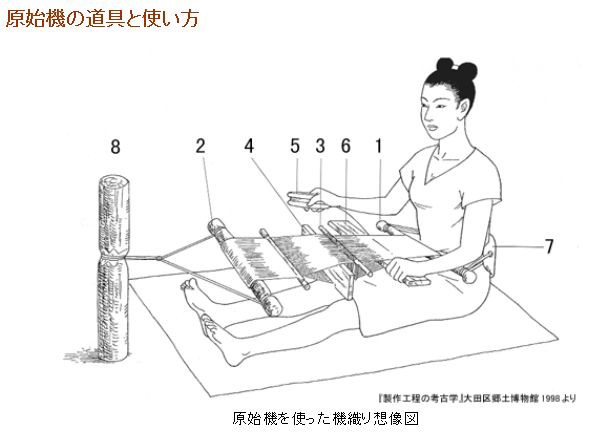In the mountainous of South East Asia, there are ethnic minorities who only wear items dyed with specific dyes. Because of the repeated dyeing process, even their fingers and skin are dyed with the colour.
When I was in my twenties, I read a book about these hill tribes and became interested in herbal dyes, especially indigo dyeing. Although it was a time when online searching didn’t exist yet, I luckily found a workshop in the countryside of Kyoto where you could try your hand at herb dyeing. So I went there to experience it.
In the first place, I wanted to try indigo dyeing, but I was also interested in “backstrap weaving” which they offered as a course in addition to herb dyeing. That was the first time I knew about it.
“Backstrap weaving”, which is called “Primitive weaving” in Japanese, literally is using a loom made on primitive principles.
In order to weave cloth, you need warp and weft yarns, which are then passed over the warp and woven together. In the primitive loom, one bundle of warp threads is fixed to a post, while the other is fixed at your low back.

You need to pass the weft from side to side in front of your belly to weave cloth.
Many people think of weaving on a loom as sitting in front of a little machine with a clattering sound and operating it. Of course, this is the most common way of weaving, but the primitive loom is a relatively low-cost way of getting started, as it can be constructed from everyday objects.
For this reason, there are still people in the countryside in South East Asia who weave cloth using this method.

If I’d just wanted to do indigo dyeing, I could have experienced it on a day trip, but the primitive loom takes a long time to weave even a small piece, so I took an overnight course.
I stayed at the workshop in Kyoto one night and wove for several hours straight. For the warp, we used thick thread, but for the weft, we used scraps of cloth that we tore and joined together instead of normal thread. That allowed me to weave much faster and over a larger area than with thread, but even so, I could only weave a little lug which was as big as a double sized table mat in two days. Obviously, it takes a lot of time to weave cloth for clothing.
Even though I was still young, sitting on the floor for two days in a row, weaving, gave me a backache. It’s because you have to keep the pressure on your back to keep the wrap straight. Every time I think of what I experienced there, it reminds me of “The Crane of Gratitude (Tsuru no Ongaeshi)” which is a famous Japanese folk tale.

There were an old man and an old woman. One winter’s day, the old man went out to work and on his way he found a crane caught in a trap. The old man felt pity for the crane and saved it.
That night, as he was telling his wife about the crane, there was a knock at the door. The grandma opened the door and saw a beautiful woman standing there in the snow.
The woman said: “I’ve come to this village to visit someone, but I’m lost. It snows very heavily. Is it possible to let me stay here for a night?”
The old couple felt sorry for her and were happy to let her stay. In return, the girl cooked and cleaned the house.
The next day, and the day after that, it continued snowing so hard that she could not go out. After a few days of living together happily, the old couple decided to let her stay at home for good.
One day she said to them: “Could you buy me a thread? I want to weave cloth.”
The granddad went into town to buy some thread and passed it to her. Before she went into the room of the loom, she said: “Now I’m going to weave, but please don’t look in while I’m doing it.”
Three days later, she came out of the loom. What she was holding in her arms was the most beautiful piece of cloth they had ever seen. The granddad took it to the town and sold it for a very high price. On his way back he bought some more yarn, and the girl went back to the loom.
Every time the girl wove beautiful cloth, the granddad sold it in town. As time went by, the grandma noticed that the girl was getting thinner and thinner with each weaving and started to wonder why. She said to her husband: “Why can she weave such beautiful cloth? Don’t you want to see what she is doing in the room?”
She couldn’t resist, so she looked into the weaving room. There was not the girl but an emaciated crane. The crane was pulling out its feathers and using them to weave cloth. Grandma was so astonished that she couldn’t help but tell her husband about it.
The sound of the loom stopped, and the girl, who was even thinner than before, came out with a beautiful piece of cloth.
She sadly said: “You have seen it, haven’t you? I am the crane who you helped the other day. I have come to the village to repay you, but I can’t stay here any longer now that you know who I am. Thank you for everything.”
As soon as she said that, she instantly transformed into a crane and flew up into the sky.
It is the story of the crane who sacrificed her own body to weave the beautiful cloth. I was told that story was inspired by the women who weave the Yuki Tsumugi (Yuki pongee) in Japan which is traditional Japanese woven fabric with silk.
Even if it is not Yuki pongee, people involved in weaving and dyeing seem to sacrifice their bodies in some way to do their work. Among the hill tribes in South East Asia, there are people who only wear clothes dyed with a certain dye, and their fingers and skin are completely stained by the dye.
Even at the cost of a little of themselves, the process of creating beautiful yarns and fabrics is fascinating. And then there is the joy of enjoying the finished product.
Dyeing yarns from nature and weaving them with time. Perhaps it is this mystery that makes the finished product shine even brighter. Just like the divine crane cloth.



Comments